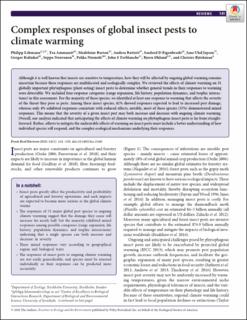| dc.contributor.author | Lehmann, Philipp | |
| dc.contributor.author | Ammunet, Tea | |
| dc.contributor.author | Barton, Madeleine | |
| dc.contributor.author | Battisti, Andrea | |
| dc.contributor.author | Eigenbrode, Sanford D. | |
| dc.contributor.author | Jepsen, Jane Uhd | |
| dc.contributor.author | Kalinkat, Gregor | |
| dc.contributor.author | Neuvonen, Seppo | |
| dc.contributor.author | Niemela, Pekka | |
| dc.contributor.author | Terblanche, John s. | |
| dc.contributor.author | Økland, Bjørn | |
| dc.contributor.author | Björkman, Christer | |
| dc.date.accessioned | 2020-04-15T10:26:52Z | |
| dc.date.available | 2020-04-15T10:26:52Z | |
| dc.date.created | 2020-02-25T12:40:23Z | |
| dc.date.issued | 2020-02-03 | |
| dc.identifier.citation | Frontiers in Ecology and the Environment. 2020, 18 (3), 141-150. | en_US |
| dc.identifier.issn | 1540-9295 | |
| dc.identifier.uri | https://hdl.handle.net/11250/2651113 | |
| dc.description.abstract | Although it is well known that insects are sensitive to temperature, how they will be affected by ongoing global warming remains uncertain because these responses are multifaceted and ecologically complex. We reviewed the effects of climate warming on 31 globally important phytophagous (plant‐eating) insect pests to determine whether general trends in their responses to warming were detectable. We included four response categories (range expansion, life history, population dynamics, and trophic interactions) in this assessment. For the majority of these species, we identified at least one response to warming that affects the severity of the threat they pose as pests. Among these insect species, 41% showed responses expected to lead to increased pest damage, whereas only 4% exhibited responses consistent with reduced effects; notably, most of these species (55%) demonstrated mixed responses. This means that the severity of a given insect pest may both increase and decrease with ongoing climate warming. Overall, our analysis indicated that anticipating the effects of climate warming on phytophagous insect pests is far from straightforward. Rather, efforts to mitigate the undesirable effects of warming on insect pests must include a better understanding of how individual species will respond, and the complex ecological mechanisms underlying their responses. | en_US |
| dc.language.iso | eng | en_US |
| dc.rights | Navngivelse 4.0 Internasjonal | * |
| dc.rights.uri | http://creativecommons.org/licenses/by/4.0/deed.no | * |
| dc.title | Complex responses of global insect pests to climate warming | en_US |
| dc.type | Peer reviewed | en_US |
| dc.type | Journal article | en_US |
| dc.description.version | publishedVersion | en_US |
| dc.rights.holder | © 2020 The Authors | en_US |
| dc.subject.nsi | VDP::Landbruks- og Fiskerifag: 900::Landbruksfag: 910::Skogbruk: 915 | en_US |
| dc.source.pagenumber | 141-150 | en_US |
| dc.source.volume | 18 | en_US |
| dc.source.journal | Frontiers in Ecology and the Environment | en_US |
| dc.source.issue | 3 | en_US |
| dc.identifier.doi | 10.1002/fee.2160 | |
| dc.identifier.cristin | 1797296 | |
| cristin.ispublished | true | |
| cristin.fulltext | original | |
| cristin.qualitycode | 2 | |

